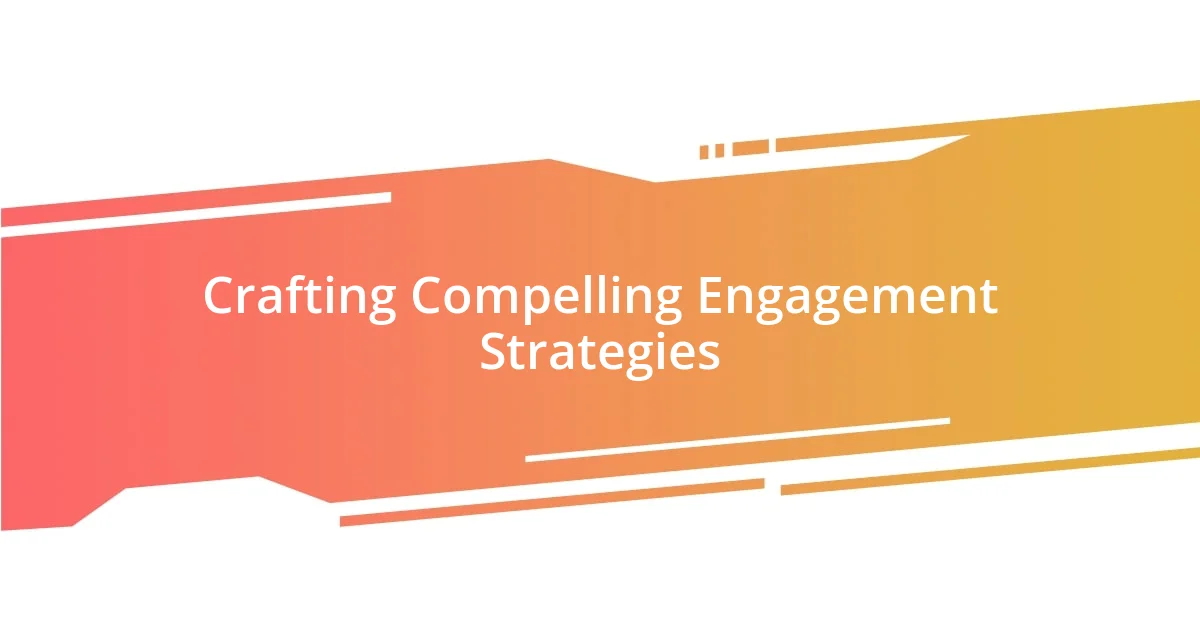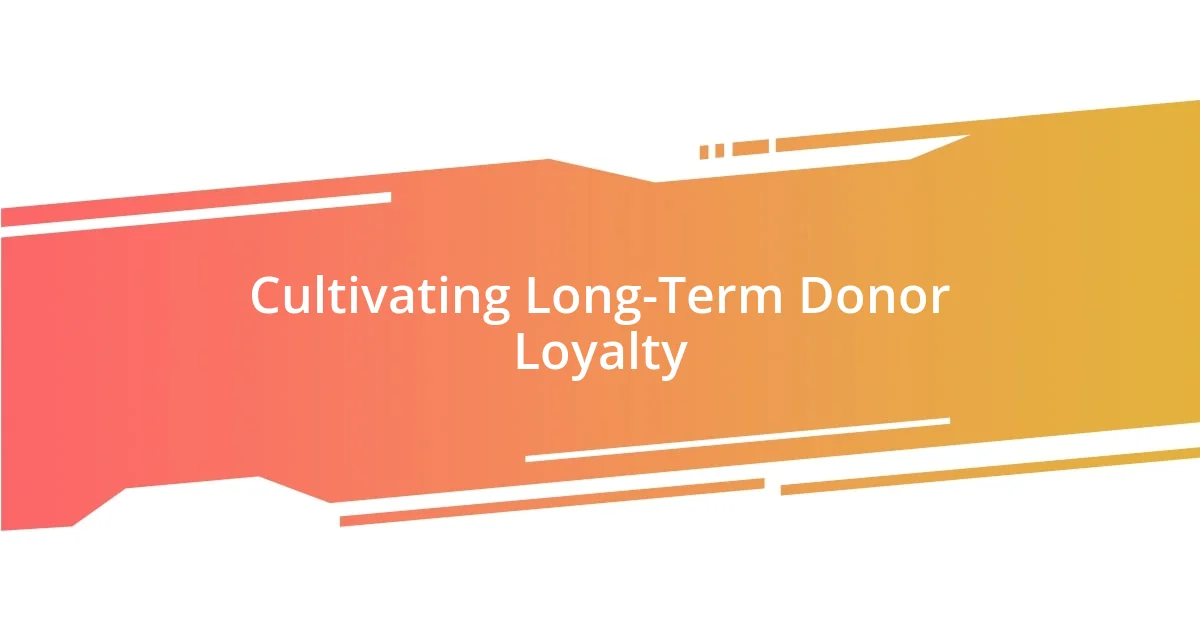Key takeaways:
- Understanding major donors involves recognizing their emotional connections to causes, which enhances their commitment and engagement.
- Personalized communication and involvement in the organization’s activities foster deeper relationships, transforming donors into passionate collaborators.
- Measuring engagement success requires both quantitative metrics and qualitative feedback, emphasizing the importance of emotional resonance in donor relationships.

Understanding Major Donors
Understanding major donors involves recognizing their motivations and values. In my experience, I’ve found that many major donors are not just looking to give money; they want to see their contributions making a real impact. Can you recall a time when you felt deeply connected to a cause? That emotional investment is precisely what drives many major donors—they seek a sense of purpose and legacy.
I’ve had the privilege of meeting a few major donors who shared the personal stories behind their philanthropy. One donor, for instance, was inspired by a family member’s experience with homelessness, prompting them to focus their giving on supportive housing initiatives. This kind of background not only enriches their commitment but also illustrates how a personal connection can create a powerful alliance between donors and organizations.
It’s crucial to understand that major donors often desire more than just transactional relationships. They want to feel valued and engaged in the mission. When I’ve taken the time to invite them to site visits or involve them in planning sessions, the bond strengthens. Have you ever felt included in something important? That’s what these donors crave—the opportunity to not only contribute but to be part of the change they wish to see.

Identifying Potential Major Donors
Identifying potential major donors requires a keen eye and a heart that understands the roots of philanthropy. I remember the moment I noticed a community member consistently attending our fundraising events. It sparked my curiosity—what motivated them? After a casual chat, I discovered their passion for education, which transformed my approach to engaging this individual. Their continued support wasn’t just about dollars; it was about aligning values and missions.
Here are some strategies I use to identify potential major donors:
- Analyze past giving patterns: Review previous contributions to see if there’s a history of significant gifts or consistent support.
- Research interests and affiliations: Look into community involvement, professional backgrounds, and any organizations they support.
- Engage with networks: Tap into mutual connections for introductions and insights on potential donors’ motivations.
- Visit public records: Check for major affiliations, such as board memberships or philanthropic work in related sectors.
By recognizing these factors, I’ve built lasting relationships that go beyond transactions, creating a community of passionate supporters eager to make a difference.

Building Relationships With Donors
Building genuine relationships with donors is pivotal to fostering a continued commitment to your organization. I remember the excitement when a major donor shared with me their vision for community development. This conversation didn’t just encompass financial contributions; it unraveled a tapestry of hopes and dreams that we could work towards together. Establishing these connections means being curious and genuinely interested in their stories, which can turn a simple transaction into a lively collaboration full of shared impact.
Personalized engagement is key—each donor is unique in their passions and interests. By hosting private gatherings that cater to their interests, like art exhibits or educational workshops related to our mission, I’ve seen donors become more emotionally invested. One donor, who was an avid nature lover, even offered to fund a local conservation project after attending a nature-related event we organized. It underscores how allowing donors to connect personally with the cause can elevate their commitment beyond mere financial support.
Ultimately, building relationships with major donors is about making them feel recognized and part of a larger family. I often reach out to share updates and invite their input, making it clear their voice matters. I recall a donor who once suggested alterations to our program based on her experiences. This sense of belonging not only empowered her but also enriched our organization. When donors feel truly valued, their involvement becomes a commitment fueled by passion and trust.
| Strategies | Examples |
|---|---|
| Active Listening | Engage with donors to understand their motivations. |
| Personal Invitations | Host tailored events that align with donors’ interests. |
| Regular Updates | Share progress and impact to keep donors informed. |

Crafting Compelling Engagement Strategies
Crafting compelling engagement strategies hinges on a deep understanding of what resonates with major donors. Imagine the moment I realized that storytelling could be the heart of my outreach. I once shared a heartfelt story about a young student whose life changed because of our program. The donor, who had struggled in their own youth, leaned in closer, clearly moved. It was in that moment I understood: we weren’t just seeking funds; we were tapping into shared narratives that foster connection and empathy.
I’ve found that creating tailored engagement opportunities can really amplify this connection. For instance, I once invited a donor to join us for a hands-on volunteer day, where she could see the impact of her support firsthand. Watching her interact with the beneficiaries was priceless; you could see the connection grow. These opportunities allow donors to feel the tangible effects of their generosity, sparking passion that’s likely to turn into long-term commitment.
Listening to donors is another essential strategy that often goes overlooked. During a casual coffee chat, one donor expressed frustration about not being informed enough about our activities. It struck me how important it is to create channels for feedback. By establishing regular, open dialogues, I’ve discovered that donors have valuable insights, which not only makes them feel valued but helps shape our programs in a way that aligns with their vision. What if we all embraced the idea that every conversation is an opportunity for collaboration?

Creating Personalized Communication Plans
Creating personalized communication plans requires a nuanced approach to truly resonate with major donors. I vividly recall a moment when I took the time to learn about one donor’s childhood experiences with art. By weaving that insight into our communications, I crafted messages that reflected not only our mission but also her personal connection. This approach transformed what could have been a mundane update into a heartfelt conversation about how her contributions were helping local artists flourish.
When I developed a tailored communication strategy for another major donor, I included segments that highlighted specific projects he expressed interest in. I can still remember the thoughtful response I received—he felt truly seen and appreciated. That simple act of personalization made a world of difference, emphasizing that communication is not just about broadcasting information but about fostering a two-way dialogue that engages and uplifts.
I’ve also found that tracking responses to personalized communications can reveal a wealth of insights. For instance, after sending a particular project update, one donor reached out with ideas on how to expand our work. This interaction highlighted the importance of creating feedback loops in our communication plans. Aren’t we fortunate to have donors who not only wish to support us financially but are also eager to innovate alongside us? By embracing their input, I’ve discovered that our relationship can evolve into a partnership that thrives on shared goals and aspirations.

Measuring Engagement Success
Measuring engagement success is not just about tracking numbers; it’s about understanding the emotional connections that underpin those metrics. I distinctly remember the thrill of receiving a heartfelt note from a donor after they attended one of our events. The words they wrote expressed not just gratitude but a true sense of belonging. This moment made me realize that metrics like attendance and fundraising totals tell one part of the story, but emotional resonance is where the real impact lies.
I’ve also found that regular surveys can be a game changer for gauging donor engagement. After sending out a simple questionnaire asking how we could improve our communications, one donor expressed a desire for more behind-the-scenes access to our projects. This feedback led to the creation of exclusive donor briefings, which not only strengthened relationships but also provided us with invaluable insights. Isn’t it fascinating how a few simple questions can open doors to deeper engagement?
Lastly, tracking donor retention rates serves as a vital indicator of success. I recall an instance where we noticed a drop in renewals from a specific group of major donors. This prompted us to reach out and reconnect through personalized check-in calls. The conversations not only revealed concerns but also reignited their passion for our mission. By treating those numbers as a starting point for dialogue, I’ve learned that true engagement requires continual efforts to understand and meet donors’ evolving needs. How often do we pause to really listen to the stories behind the data?

Cultivating Long-Term Donor Loyalty
Building long-term donor loyalty goes beyond mere transactions; it’s about fostering a genuine connection. I remember one major donor who had consistently supported us for years. During a casual lunch, she shared how much her late grandmother had inspired her philanthropic journey. By acknowledging that bond and referencing it in our future conversations, I turned our relationship into a heartfelt partnership, rather than just a financial exchange. Isn’t it remarkable how such personal stories can deepen commitment?
In my experience, creating opportunities for donors to engage with the cause can solidify their loyalty. One time, I invited a donor to participate in a project launch, where they could meet the beneficiaries of their generosity. The spark in their eyes as they witnessed the impact firsthand was unforgettable. I realized then that providing these immersive experiences helps donors feel part of something bigger. How often do we think about the power of shared experiences in nurturing donor relationships?
Donor appreciation also plays a crucial role in sustaining loyalty. I once arranged a small gathering to thank a group of major donors for their ongoing support. Sharing not just our successes, but also the challenges we faced, created an atmosphere of transparency and trust. This openness encouraged open dialogue and helped them feel valued for their contributions, cementing their commitment to our mission. What if we all took the time to show our gratitude in meaningful, personalized ways?















